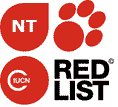| Higher Taxa | Anolidae, Iguania, Sauria, Squamata (lizards) |
| Subspecies | Anolis monticola monticola SHREVE 1936
Anolis monticola quadrisartus THOMAS & SCHWARTZ 1967 |
| Common Names | E: La Hotte Bush Anole, Foothill Anole |
| Synonym | Anolis monticola SHREVE 1936: 93
Anolis monticola — THOMAS & SCHWARTZ 1967: 11
Anolis monticola — SCHWARTZ & HENDERSON 1991: 304
Anolis monticola — NICHOLSON et al. 2005
Deiroptyx monticola — NICHOLSON et al. 2012
Deiroptyx monticola — NICHOLSON et al. 2018
Anolis monticola monticola SHREVE 1936
Deiroptyx monticola monticola — NICHOLSON et al. 2012
Deiroptyx monticola monticola — NICHOLSON et al. 2018
Anolis monticola quadrisartus THOMAS & SCHWARTZ 1967: 17
Deiroptyx monticola quadrisarta — NICHOLSON et al. 2012
Deiroptyx monticola quadrisarta — NICHOLSON et al. 2018 |
| Distribution | Hispaniola (Haiti: Monts Cartaches, Massif de la Hotte, elevation from about 1300 ft. to 4600 ft.)
monticola: extreme distal portion of Tiburon Peninsula, on northern and western Massif de la Hotte and Monts Cartaches. Type locality: Northern and eastern foothills, Massif de la Hotte (= Pic Macaya), [elevation] 1000 ft. to 4000 ft., Département de la Grand'Anse, Haiti.
quadrisartus: southern and eastern Massif de la Hotte.
|
| Reproduction | oviparous |
| Types | Holotype: MCZ 38296
Holotype: MCZ 62998 [quadrisartus] |
| Diagnosis | Additional details, e.g. a detailed description or comparisons (1644 characters), are available for collaborators and contributors. Please contact us for details. |
| Comment | For illustrations see Williams, 1962 a; Thomas and Schwartz, 1967.
Species group: Deiroptyx hendersoni species group (fide NICHOLSON et al. 2012). |
| References |
- Griffin, D. K., Kretschmer, R., Srikulnath, K., Singchat, W., O’Connor, R. E., & Romanov, M. N. 2024. Insights into avian molecular cytogenetics—with reptilian comparisons. Molecular Cytogenetics, 17(1), 1-23 - get paper here
- Losos, J. B. 2009. Lizards in an Evolutionary Tree: Ecology and Adaptive Radiation of Anoles. Berkeley: University of California Press, 528 pp. - get paper here
- Nicholson, K. E., R. E. Glor, J. J. Kolbe, A. Larson, S. B. Hedges, and J. B. Losos 2005. Mainland colonization by island lizards. Journal of Biogeography 32: 929–938 - get paper here
- NICHOLSON, KIRSTEN E.; BRIAN I. CROTHER, CRAIG GUYER & JAY M. SAVAGE 2012. It is time for a new classification of anoles (Squamata: Dactyloidae). Zootaxa 3477: 1–108 - get paper here
- NICHOLSON, KIRSTEN E.; BRIAN I. CROTHER, CRAIG GUYER & JAY M. SAVAGE 2018. Translating a clade based classification into one that is valid under the international code of zoological nomenclature: the case of the lizards of the family Dactyloidae (Order Squamata). Zootaxa 4461 (4): 573–586 - get paper here
- Poe, S. 2004. Phylogeny of anoles. Herpetological Monographs 18: 37-89 - get paper here
- Poe, S. 2013. 1986 Redux: New genera of anoles (Squamata: Dactyloidae) are unwarranted. Zootaxa 3626 (2): 295–299 - get paper here
- Schwartz, A. & Henderson, R.W. 1991. Amphibians and Reptiles of the West Indies. University of Florida Press, Gainesville, 720 pp.
- Shreve, B. 1936. A new Anolis and new Amphibia from Haiti. Proc. New England Zool. Club 15: 93-99.
- Thomas, R. and A. Schwartz. 1967. The monticola group of the lizard genus Anolis in Hispaniola. Breviora (261):1-27. - get paper here
- Williams, E. E. 1962. Notes on the herpetology of Hispaniola 7. New material of two poorly known anoles: Anolis monticola Shreve and Anolis christophei Williams. Breviora (164):1-11. - get paper here
- Williams, E. E. and T. P. Webster. 1974. Anolis rupinae new species, a syntopic sibling of A. monticola Shreve. Breviora (429): 1-22 - get paper here
- Yuan, M. L., M. H. Wake, and I. J. Wang. 2019. Phenotypic integration between claw and toepad traits promotes microhabitat specialization in the Anolis adaptive radiation. Evolution 73: 231–244 - get paper here
|
| External links |
|
![]()


